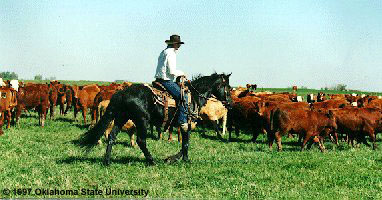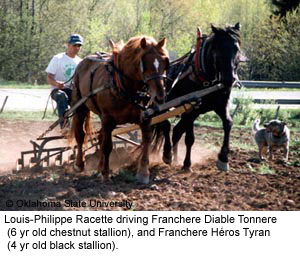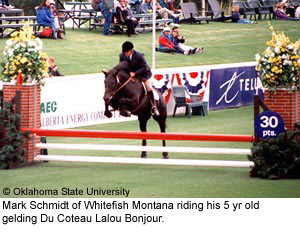

This page has been purloined from: http://www.ansi.okstate.edu/BREEDS/HORSES/
- a great site for horses.
The Canadian Horse is a little known national treasure of Canada. This hardy breed descended from horses originally sent to the “New World” by King Louis XIV of France in the late 1600’s. These Norman and Breton horses were felt to be of Arab, Andalusian and Barb ancestry – traits of which can still be recognized in the Canadian Horse today.
For hundreds of years, the French horses bred with little influence from outside breeds. They eventually developed into their own distinct breed - the Canadian Horse or Cheval Canadien. Because they evolved under the adverse conditions of harsh weather, scarce food, and hard work, the Canadian Horse remains the sturdiest and most acclimatized horse in Canada today. They are tough, strong horses, tolerant of inclement weather conditions, and are extremely “easy keepers”. Because of these traits, the Canadian Horse is often referred to as “The Little Iron Horse”.
In the mid-1800’s, the Canadian Horse numbered about 150,000 and could be found throughout Canada and the United States. The Canadian was used for crossbreeding to improve the strength and hardiness of other breeds, and helped to found other North American breeds such as the Morgan, Tennessee Walking Horse, Standardbred, and the American Saddlebred. Increasingly, Canadian Horses were exported out of Canada for the Boer war, for working the sugar plantations in the West Indies, and to the United States for use on the stage-lines and for the American Civil War. The number of horses began to dwindle rapidly. With the advent of mechanized farm machinery, the Canadian Horse almost became extinct. During the 1960-70’s, there were fewer than 400 horses in existence and 20 or less registrations recorded per year. By the late 1970’s, the peril of Canada’s national breed was finally recognized, and efforts were made by diligent breeders to try to bring the Canadian Horse back from the verge of extinction.

Under the leadership of Dr. J.A. Couture, DVM, a few concerned admirers of the "Little Iron Horse" banded together to try and preserve what remained of the breed. Their efforts produced a first stud book in 1886. Progress was slow however, and it was not until 1895, when the Canadian Horse Breeders Association was formed that any real expansion took place. In 1907 under the leadership of Dr. J.G. Rutherford, the Federal Government livestock commissioner, a new stud book was started with improved standards.In 1913 the Federal Ministry of Agriculture set up a breeding program at Cap Rouge, Quebec, where Albert De Cap Rouge, one of the foundation studs was bred. There were other breeding programs set up in Quebec at St. Joachim and La Gorgendiere that continued to breed the Canadian Horse until 1981.
Now, the breed is slowly gaining in popularity, and currently numbers just over 2500 horses in existence. The Canadian Horse is still classified as “critical” on the American Livestock Conservancy list.

The Canadian Horse can be called a general utility animal. From the very beginning of New France it was valuable not only for plowing, but also as a carriage horse. Breeders appreciated the qualities of strength, willingness, and small food requirements. The breed is long lived and still useful at an advanced age. The mares are extraordinarily fertile, and reproduce regularly until the age of 20 or older.The historian Taillon depicts the old Canadian Horse as follows:
"Small, but robust, hocks of steel, thick mane floating in the wind, bright and lively eyes, pricking its sensitive ears at the least noise, going along day and night with the same courage, wide awake beneath its harness; spirited, good, gentle, affectionate, following his road with the finest instinct to come surely home to his own stable. Such were the horses of our fathers."
The Canadian Horse typically stands 14 – 16 hh and weighs 1000 – 1400 lb. Although most frequently black, they may also be dark brown, bay or chestnut. They are characterized by their finely chiseled heads, arched necks, and thick, long, wavy manes and tails – all reminiscent of their Barb and Andalusian ancestry. They have strong, sturdy legs and short cannon bones often exceeding 9” in circumference. Their feet are exceptionally well formed and tough, and generally require little more than routine trimming. Best of all, Canadian Horses are renowned for their kind, sensible, sociable natures, intelligence and willingness to please.
Breed Standard

Head
Head: Rather short with straight lines, lean, carried high and slanting Ears: Set well apart, thin, active, rather short Forehead and face: Broad and flat Eyes: Wide apart, flush with head, large, moderately convex, bright, kind, active Eyelids: Thin, clean, mobile Nostrils: Large, wide apart Lips: Thin, firm, mobile with delicate skin Mouth: Rather small Jaw: A bit wide through the jaw, broad at the lower angle Jaw cavity: Wide, lean, well hollowed Cheeks:Well developed, firm not fat
Neck and throat
Throat: Wide, throatlatch slightly smaller Neck: Fairly arched, broad at base and thin at top, medium length, sides slightly rounded and firmly muscled, gracefully attached to head and shoulders Mane: Abundance of fine hair
Body
Chest: Broad and deep, legs well apart Ribs: Long, broad, well arched Girth: Well developed Withers: Lean, clean, slightly raised, long Back: Strong, straight, well proportioned, broad, short Loins: Broad, well proportioned to back, well attached to croup, strongly muscled Belly: Somewhat large but not pendulous, following curve of ribs and short,well-rounded flanks.
Frontquarters
Shoulders: Long, sloping, well muscled Forearms: Long, straight, covered with hard, projecting muscle Elbows: Parallel to axis of body, broad Knees: Lean, long, broad, thick, clean, straight Cannons: Short, flat, thick, lean, clean, perpendicular, tendons well attached Fetlocks: Thick, lean, clean, hair acceptable Pasterns: Thick, average length, moderately slanting Feet: Average size, resting squarely on ground, frontline following pastern's inclination, heels open, same size, landing vertically on the ground, sole hollow, thick with well-developed fork
Hindquarters
Hips: Slightly protruding, even Croup: Long, fairly broad, slightly sloped, well muscled Tail: Large at root, attached rather high, carried well, abundance of fine, long hair Stifles: Clean, close to belly, turned slightly outward Thighs and buttocks: Broad, thick, long, descending as close to hock as possible, well muscled Legs: Proportionate length, large, lean, well-developed muscles, protruding slightly to out-side Hocks: Clean, lean, large, thick, flat-faced, parallel to incline of body, very flexible Cannons: Short, broad, flat, lean, clean, perpendicular, tendons well separated from bones, large, firm Fetlocks: Broad, thick, lean, clean Pasterns: Broad, thick, lean, clean, average length, slightly slanting Feet: Same size and qualities as front feet but less developed, oval shape with heels higher and more spread
Evaluation of type
Height: 14hh to 16hh Weight: Proportionate to height Outline: Shows power and agility through well-balanced and proportioned good quality body parts Quality: Coat soft and shining, mane thick and long, skin soft and elastic, bones dense and clean, joints lean and clean Gaits: Free and vigorous movement, hocks, knees, fetlock, pasterns bending well in higher movements, harmonious Appearance: Graceful carriage and symmetry of shape, stands squarely on ground Temperament: Energetic and spirited without nervousness, calm, docile Colors: Black, chestnut, bay, dark brown
Breed Associations and Registries
Reference:
Dennis & Tamie Dyck, Lazy D Ranch, Rosemary, AB T0J 2W0 Email: cdnhorse@eidnet.orgPhotographs:Yvonne and Jim Hillsden, Kamloops, BC V2C 6C3 E-mail: cdnhorse@bc.sympatico.ca
Mason, I.L. 1988. World Dictionary of Livestock Breeds. Third Edition. C.A.B International.
Dennis & Tamie Dyck, Lazy D Ranch, Rosemary, ABYvonne and Jim Hillsden, Kamloops, BC